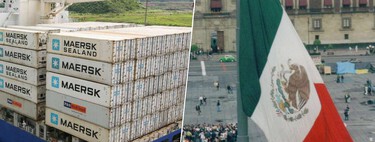During a period in our history, the train was the backbone of many countries. In Mexico it was no less important and, at the beginning of the 20th century, built thousands of kilometers to connect key points of the country with Mexico City. In recent years we have had such colossal (and controversial) projects as the Mayan Train to mobilize tourism, but now the commercial train is once again the protagonist in the country.
Your plan? Resume the Interoceanic Corridor to compete against the Panama Canal and revitalize almost 3,000 kilometers of roads.
Interoceanic Corridor. Let’s start talking about the country’s great commercial project. In the mid-19th century, Mexico had a plan to connect Mexico City to the coastal city of Veracruz. Dozens of cities were going to benefit from this, known as the ‘interoceanic railway’, since the 1897 plan was to connect the aforementioned Veracruz, in addition to Mexico City, with Acapulco. That is to say: a train that would go from the Gulf of Mexico to the Pacific.
However, there is another corridor, that of the Isthmus of Tehuantepec. This connects the Atlantic and the Pacific through the narrowest part of Mexico, but ended up in disuse, among other things, because the Panama Canal already fulfilled that function as a transit point for goods. And many more containers fit on a container ship than on a train. However, the recent Panama Canal crises encouraged the previous government of Andrés Manuel López Obrador to try again with the Tehuantepec corridor.
Ambition. This interoceanic corridor will count with three lines and a branch, totaling just over 1,000 kilometers and an estimated cost of 6.2 billion euros for the development poles of the route and another 2.5 billion euros for the construction of roads. At the end of 2023, the Secretary of Economy, Raquel Buenrostro, commented that “Mexico is, at this moment, one of the most attractive countries, among the five most attractive in the world. There is no way for this not to develop.”
And it is an interesting project because it can greatly shorten the delivery times of goods to the United States, going from ten hours per shipment through the Panama Canal to just over six hours if transported by train. It doesn’t seem like much, but adding travel, it is something that can bring certain industries closer to the United States (and without delays due to droughts, which are exceeding 20 days in some months). In numbers, the Interoceanic Train of the Isthmus of Tehuantepec aspires to:
- Two oceans joined by 303 kilometers directly from coast to coast.
- Containers that will take about six hours to cross.
- Estimated 1.4 million containers annually.
- Expansion of the port of Salina Cruz from 14 to 24 meters of draft to admit larger ships.
- Additional lines and connections with Palenque/Tren Maya and with Ciudad Hidalgo/Guatemala.
Competence. Buenrostro acknowledged that a train cannot carry the same amount of cargo as a ship, but that “given the changes we are experiencing with climate change, the train is a real and increasingly important alternative.” In fact, the Chinese industry is looking favorably on investing in Mexico due to both the opportunities in the country and, above all, because it would be easier to introduce its products in the United States. López Obrador commented that they do not want to “compete with our Panamanian brothers. It is about having other options because there are possibilities, since trade with Asia has grown a lot.”
BBC went on contact with both Mexican and Panamanian experts, who agree that it would not be a direct competition. Benjamín Alemán is the former director of the Mexican Railway Transportation Regulatory Agency and commented that “ships with smaller loads, not necessarily containers, could arrive in Mexico and go to other destinations in the United States. It could even be interesting for Mexican companies that want distribute products in the Mexican southeast”.
Connecting Mexico. The reason is that, once this corridor is established, the idea is that it be linked in some way with both Mexico and several border points with the United States. And that’s where the current president’s plan comes into play. Claudia Sheinbaum’s administration stated recently that it plans to launch some 3,000 kilometers of roads for passenger transportation. The idea is to connect both the main cities in the interior of Mexico such as Mexico City directly with Texas and Arizona.
This is the plan which will use roads already built, others to be rehabilitated and others completely new:


Problems with drug traffickers. The plans seem promising and for both the movement of goods and people, they are very interesting, but there is a problem. In the Financial Times, representatives of the port industry show worried about making investments of hundreds of millions of dollars if we really still don’t know if there is a market.

Furthermore, some voices have also been raised that indicate that part of the routes confirmed by the president cross or are near areas controlled by organized crime. One of the routes that appears on the proposed map coincides with one of the narcotics smuggling lines from Mexico to the United States. Taking into account the presence of organized crime in all levels of Mexico, this will be one of the challenges that the country will face to fulfill its railway plans.
Images | ProtoplasmaKidS.N.T.
In Xataka | The Mayan Train has put Mexico’s treasures in the spotlight. Now is the time to dress them up








![[Img #74675]](https://thelatestnews.world/wp-content/uploads/2024/12/They-discover-a-new-class-of-X-ray-sources-in-the-150x150.jpg)




![[Img #74675]](https://thelatestnews.world/wp-content/uploads/2024/12/They-discover-a-new-class-of-X-ray-sources-in-the-300x200.jpg)

Add Comment